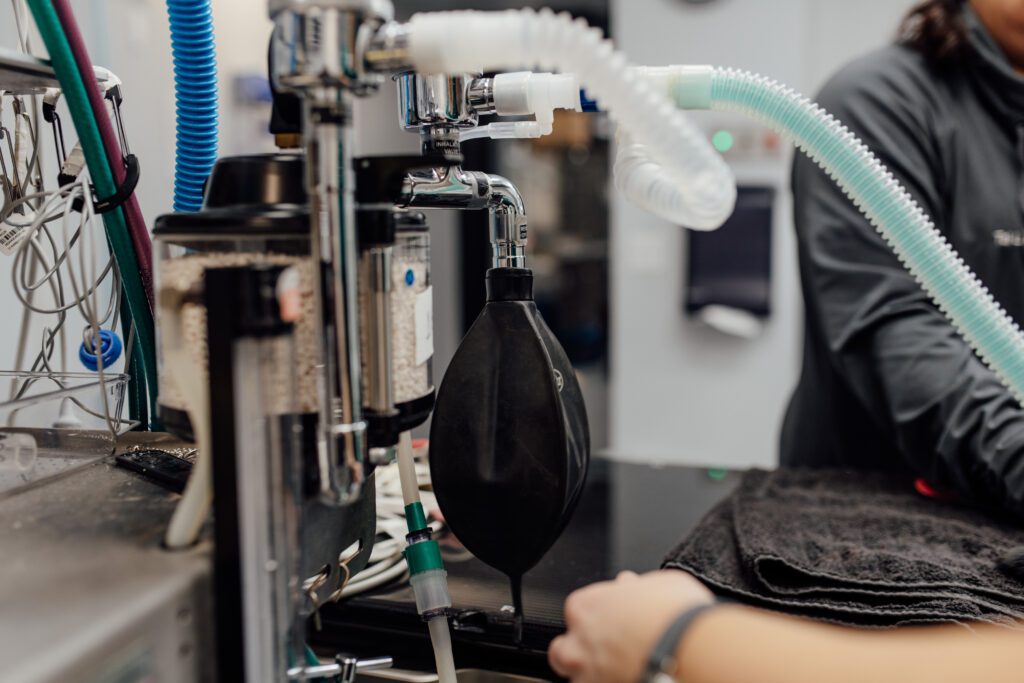Radiation Therapy – Apocrine Gland Anal Sac Adenocarcinoma
 Apocrine gland anal sac adenocarcinomas (often abbreviated as AGASACA) are malignant tumors of the glands surrounding the perineum and anal sphincter. They account for 17% of all perianal tumors and 2% of skin tumors in dogs. Most dogs are middle-aged to older when they develop this disease. The clinical signs that often alert owners to a problem in the perianal region can include scooting on the floor, licking at the perianal region, straining to defecate or vocalizing while defecating, being protective or painful in the hind end, or seeing a visible mass in the perianal region. Up to 40% of dogs will have a perianal mass found incidentally at their annual or biannual check-ups by your veterinarian during a rectal exam. A ¼ to ½ of dogs with AGASACA will also have elevated calcium in the blood, which can make them feel ill, lethargic, increase their water intake and urination, and decrease their appetite. In severe cases, patients with very high calcium levels can develop tremors, behavioral changes, and seizures.
Apocrine gland anal sac adenocarcinomas (often abbreviated as AGASACA) are malignant tumors of the glands surrounding the perineum and anal sphincter. They account for 17% of all perianal tumors and 2% of skin tumors in dogs. Most dogs are middle-aged to older when they develop this disease. The clinical signs that often alert owners to a problem in the perianal region can include scooting on the floor, licking at the perianal region, straining to defecate or vocalizing while defecating, being protective or painful in the hind end, or seeing a visible mass in the perianal region. Up to 40% of dogs will have a perianal mass found incidentally at their annual or biannual check-ups by your veterinarian during a rectal exam. A ¼ to ½ of dogs with AGASACA will also have elevated calcium in the blood, which can make them feel ill, lethargic, increase their water intake and urination, and decrease their appetite. In severe cases, patients with very high calcium levels can develop tremors, behavioral changes, and seizures.
At the time of diagnosis, it is quite variable whether a patient has developed spread of their disease beyond the anal sac, with some studies reporting 30% up to >90% of dogs having disease elsewhere. Most commonly AGASACAs first spread to the lymph nodes in the abdomen, just under the lumbar spine, but from there can also be found in the liver, spleen, lining of the abdomen (carcinomatosis), and lungs. Fully staging your pet at the time of diagnosis, including complete blood work, chest x-rays, abdominal ultrasound, and sampling of any enlarged or abnormal lymph nodes and organs is recommended to determine how advanced the disease is and what treatment options are available.
If a mass is not too large, many times surgical removal of the mass is the first-line therapy. This can immediately improve your pet’s clinical signs. Tumor control times are variable, ranging from 8 months up to 3.5 years, with larger tumors doing worse than tumors caught when they are small. Risks with surgery can include bleeding and fecal incontinence, however, these are often dependent on tumor size. A consultation with a veterinary surgeon for how your particular pet would do is highly recommended. This therapy alone can often have good outcomes. Most tumors will grow back, however, it can take many months to years before recurrence of the mass is noted or it spreads to elsewhere in the body.
 If the mass was not completely removed, the mass is not surgical, or you elect a non-invasive approach, radiation is a great supplementary or secondary option. Surgery followed by radiation to the scar with or without irradiation of the lymph nodes under the lumbar spine has been shown to control these tumors for up to 2.5 years. This protocol entails 20 days of radiation, Monday through Friday, and each day your pet would be anesthetized briefly. This protocol does cause radiation side effects to the perianal region, rectum, and colon depending on the extent of the tumor (see our handout on Radiation Therapy side effects). Most commonly these side effects occur about 2 weeks after starting radiation and persist for 2-3 weeks after radiation is completed. The most severe side effects occur during the end or right after radiation is completed. Diarrhea, pain while defecating, or red, inflamed and/or ulcerated skin around the anus have been reported. Chronic diarrhea lasting > 6 months after therapy has been reported in 30-50% of dogs; at VSC we have elected a protocol to diminish that risk as much as possible.
If the mass was not completely removed, the mass is not surgical, or you elect a non-invasive approach, radiation is a great supplementary or secondary option. Surgery followed by radiation to the scar with or without irradiation of the lymph nodes under the lumbar spine has been shown to control these tumors for up to 2.5 years. This protocol entails 20 days of radiation, Monday through Friday, and each day your pet would be anesthetized briefly. This protocol does cause radiation side effects to the perianal region, rectum, and colon depending on the extent of the tumor (see our handout on Radiation Therapy side effects). Most commonly these side effects occur about 2 weeks after starting radiation and persist for 2-3 weeks after radiation is completed. The most severe side effects occur during the end or right after radiation is completed. Diarrhea, pain while defecating, or red, inflamed and/or ulcerated skin around the anus have been reported. Chronic diarrhea lasting > 6 months after therapy has been reported in 30-50% of dogs; at VSC we have elected a protocol to diminish that risk as much as possible.
If there is palpable or visible tumor, radiation can also be used alone for tumor control. There are a variety of protocols out there. A definitive protocol, as described above for scars, can be effective and tumor control time is usually 1-2 years. More palliative radiation options, with fewer doses of radiation, spread out by several days, have fewer side effects and tumor control times ranging from 6 months up to 1 year.
The options we offer at VSC are below. Most of these protocols have similar efficacy, however, consult with the radiation oncologist to see if one protocol might be preferred for your individual pet.
- Once a week for 6 weeks
- Once a day for 5 days
- Monday, Wednesday, Friday treatments for 8 total doses
The side effects associated with these palliative protocols are much lower, both in severity and frequency. Many patients can complete a protocol and not experience any side effects, however, this risk is never zero.
Thank you for considering bringing your pet to us for treatment. We understand and value the trust you have placed in us. Should you have any questions regarding radiation therapy for the treatment of canine anal sac tumors, please do not hesitate to ask to be put in contact with a member of our radiation oncology team.
Radiation Therapy – Apocrine Gland Anal Sac Adenocarcinoma – Download
